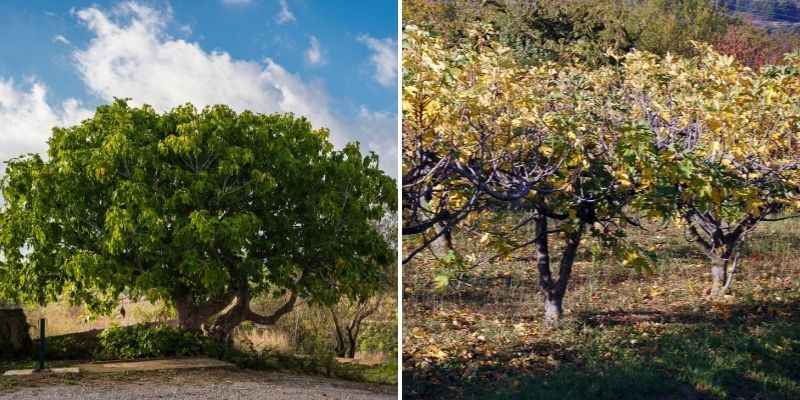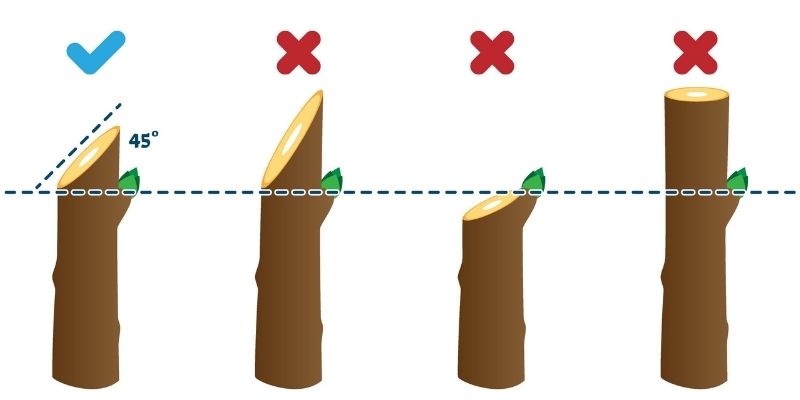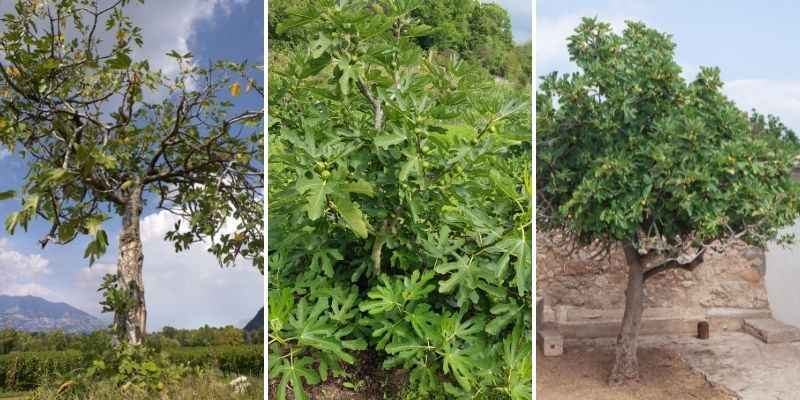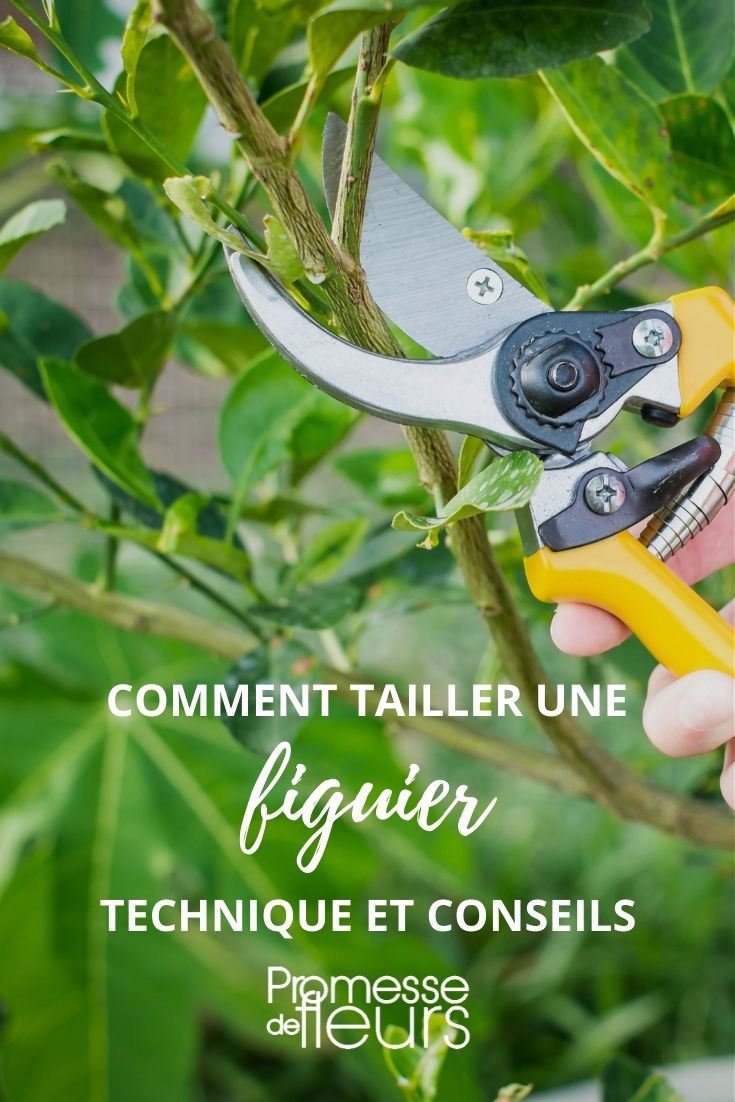Pruning the fig tree is not always necessary, but it helps control its size, facilitate fruit harvesting, and improve production. For a mature and vigorous fig tree, an annual light pruning is often recommended, especially in cooler regions to encourage fruiting. So, when and how to prune a fig tree? Discover in this tutorial all our tips for a healthy tree, with a beautiful shape and an abundant harvest of figs.

On the left, a large fig tree where the high-up figs are difficult to harvest. On the right, pruned fig trees for harvesting fruit at waist height.
When to prune a fig tree?
The pruning period for a fig tree depends on the region where the tree is planted and the type of fig tree. To determine the best months to prune a fig tree, it is generally recommended to prune in late winter or early spring, ideally between February and March, before new growth begins.
- In cold regions, winters are harsher, and uniferous fig trees are preferred. Prune them in late winter (late February/March).
- In mild climates, biferous fig trees are more commonly grown. You can prune this fig tree in late winter or possibly just after harvest, i.e., in autumn, between October and November.
How to prune a fig tree?
There are two types of fig trees:
- Uniferous fig trees: They produce fruit only once a year, in late summer (August/September, sometimes October) on the current year's branches.
- Biferous fig trees: They fruit twice a year. In early summer (June/July), the breba figs or summer figs develop on the previous year's wood. In autumn (late August to October), the autumn figs are harvested. These grow on the current year's wood.
Please note: uniferous and biferous fig trees are not pruned in the same way.
→ Also check out Olivier's advice sheet: Biferous or uniferous fig tree: what are the differences?
Tools needed for pruning
- Well-disinfected and sharpened pruning tools: secateurs, loppers, and pruning saw for thick branches
- Pruning sealant
Good to know: as fig tree sap is irritating, wear gloves. Sap on the skin and exposure to sunlight can cause burns and blisters.
Good pruning practices
- Do not prune in rainy weather.
- Cut branches at an angle, above an outward-facing eye, so water won’t pool on the cuts and disease risk is reduced.
- Always remove dead or diseased wood.
- Open up the tree’s centre by removing crossing or inward-growing branches so future fruits get maximum light.
- Cut low-hanging branches, those pointing downwards, overly thin ones, frost-damaged branches, as well as poorly formed shoots and the oldest ones.

Make clean cuts above buds to minimise disease risk: angled cut at 45°, neither too high nor too low
Pruning biferous fig trees
For biferous fig trees, in February/March, do not cut last year’s branches. These bear globose, rounded buds that will become breba figs in summer. These buds formed before winter and will develop in spring. If you remove these shoots, you won’t get summer fruit. Leaf and wood buds, however, are pointed. If unsure, wait until buds develop further to better distinguish the two types.
- On shoots with breba fig buds, remove all leaf buds (disbudding), except the first outward-facing leaf bud at the base of each branch.
- After the first harvest, in late July/August, cut above the bud left in March, which has grown into a shoot. These new shoots will produce the second harvest in September/October. Trim their tips to prevent excessive branch growth and encourage good autumn fruiting.
- After the autumn harvest, remove the oldest branches from the stump that need renewing.
Pruning uniferous fig trees in late winter
Since this fig tree fruits only once a year in autumn, pruning it in late winter the following year won’t affect the next autumn harvest. This pruning is simpler than for biferous fig trees. It’s highly recommended in cooler regions, annually in late winter, to concentrate sap where needed and give figs time to ripen. Here are our maintenance pruning tips:
- Shorten long shoots by about a third, as well as secondary shoots above the 3rd outward-facing eye (counting from the shoot base). The fig tree will produce new wood by autumn, on which figs will appear.
- After pruning, the fig tree will produce many suckers. To focus sap on fruiting, during the year, select suckers to replace old branches and remove the rest. To avoid exhausting the tree, a dozen main branches are enough.
- After harvesting figs, cut back the year’s fruiting shoots if you choose not to prune the fig tree the following late winter.
How to prune a young fig tree?
Formative pruning shapes the tree’s framework. For this, in the first three years, remove crossing branches in the tree’s centre. This lets light penetrate easily. Also cut branches growing too outward. The remaining framework branches should form a nice crown (standard fig tree) or clump (bush fig tree). Pinch the tips of shoots (leaf/wood buds) in late winter to encourage branching.
How and why to rejuvenate an old fig tree?
Very old fig trees produce fewer fruits and become bare at the base. To restore a balanced shape and vigour, more severe pruning is needed and can be done every 20-25 years to avoid exhausting the tree. Rejuvenation pruning involves cutting back stump branches to 50 cm above ground level.
For an old multi-stemmed (bush) fig tree
Prune half the branches the first year, the rest the next. Branches left the first year act as sap drawers. New stems will grow on cut branches. Keep only half and trim them for better fruiting.
For an old single-trunk fig tree
Shorten all branches to 50 cm from the trunk’s end. Suckers will appear. In summer, remove half and shorten the rest by a third. Repeat next year before switching to maintenance pruning.
If you need to reduce a fig tree’s height
You can convert an old single-trunk fig tree into a bush. Cut it back to ground level. In spring, keep only the sturdiest suckers and lightly trim them for better branching.
Tip: To remove large or long branches and avoid bark tearing, cut them in two stages.

Old fig tree, bush-shaped multi-stemmed fig tree, and single-trunk fig tree
Aftercare following pruning
As fig trees are prone to disease after pruning, we recommend protecting cuts with a sealant (ready-to-use sealant for fruit trees). Diseases like fig canker can enter through wounds. A weakened tree may then attract other diseases or parasites.
Apply sealant immediately after pruning, ensuring it covers the cut edges. This also protects against late frosts in April.
Common mistakes to avoid
- Pruning too late in the season: This can reduce next year’s fruit production.
- Over-pruning: Excessive pruning may stimulate foliage growth at the expense of fruit.
- Not pruning at all: Lack of pruning can lead to an overly dense tree with poor air and light circulation.
- Ignoring the fig tree type: Some fig trees fruit on previous year’s wood (breba figs), others on current year’s wood (autumn figs).
- Not disinfecting pruning tools: This can spread diseases between branches or trees. Always use clean, sharp tools.
- Pruning young trees too early: Let young fig trees establish before significant pruning.
- Forgetting to remove dead, diseased, or crossing branches



































Comments